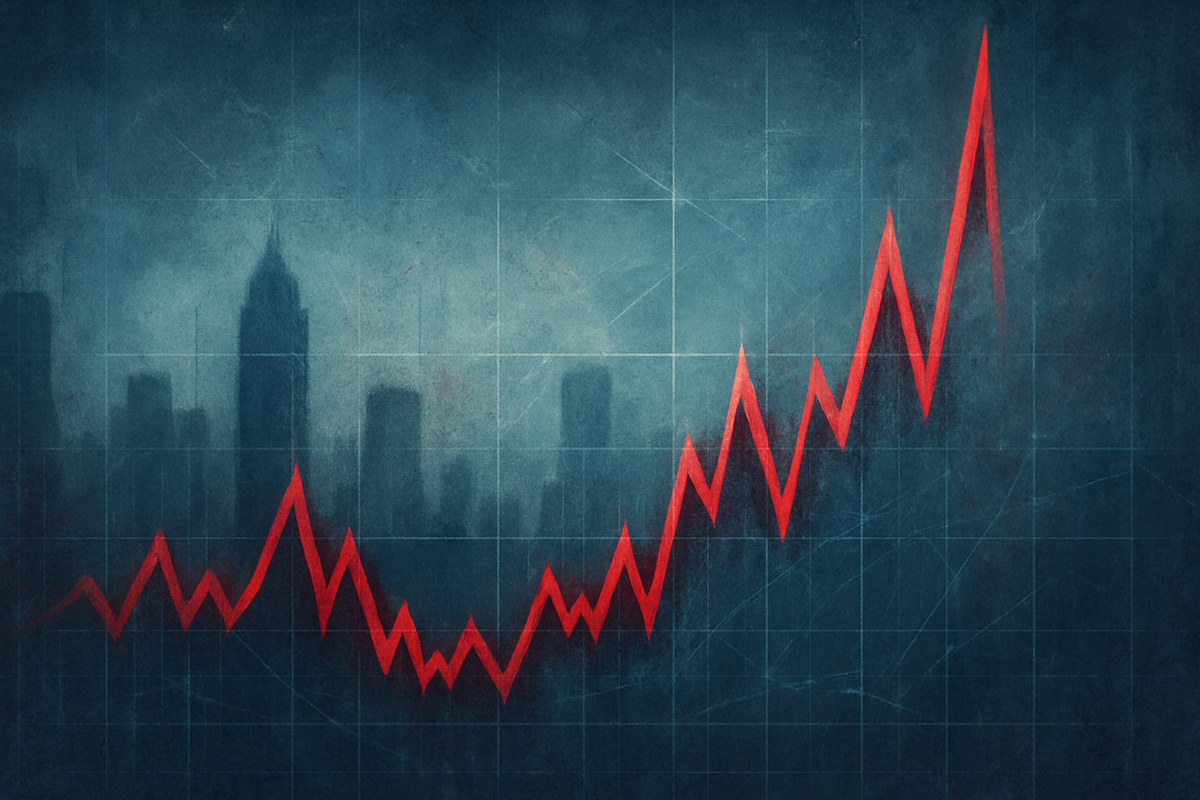
As of early November 2025, the financial markets are navigating a landscape marked by subtle shifts in investor sentiment, with the Market Volatility Index (VIX), often dubbed the "Fear Index," hovering in a moderate range. Currently observed between 17 and 19, the VIX signals a market that, while not in outright panic, is certainly not complacent. This level reflects an underlying layer of investor uncertainty and a proactive stance on hedging against potential downturns, even as major economic data releases loom large on the horizon.
The VIX’s current positioning suggests a market grappling with mixed signals: strong underlying economic fundamentals in some sectors, juxtaposed with lingering concerns over valuation in others, particularly within the tech sphere. This delicate balance means that while extreme fear is absent, a palpable sense of caution pervades, influencing investment strategies and risk assessments across the board. Understanding the VIX is not just about measuring fear; it's about anticipating market movements and identifying potential areas of opportunity or vulnerability.
The Anatomy of Market Anxiety: How the VIX Quantifies Uncertainty
The Market Volatility Index (VIX) is a cornerstone of financial market analysis, serving as the Cboe Global Markets (CBOE) (NASDAQ: CBOE) real-time measure of the market's expectation of short-term volatility in the S&P 500 (INDEXSP: .INX) index. Unlike traditional indices that track price movements, the VIX quantifies implied volatility, essentially reflecting the market's collective forecast of how much the S&P 500 will fluctuate over the next 30 days. This makes it a powerful barometer of investor sentiment, with higher values indicating greater expected volatility and, consequently, increased market fear.
The calculation of the VIX is a sophisticated process that leverages the real-time prices of a wide array of S&P 500 call and put options with varying strike prices and two consecutive expiration dates. Instead of relying on a theoretical pricing model, it directly derives expected volatility by interpolating the variances of these options. This methodology ensures that the VIX captures the market's forward-looking perspective on risk. Historically, the VIX was introduced by the CBOE in 1993, initially tracking the S&P 100. However, in 2003, it was updated to its current, more comprehensive form, shifting its focus to the broader S&P 500, solidifying its role as the premier gauge of U.S. equity market volatility.
Typical reactions to VIX movements provide clear insights into market dynamics. A VIX below 20 generally signifies stable, stress-free markets, often indicative of investor optimism or even complacency. Levels between 20 and 30 suggest a normal degree of market volatility, reflecting a balanced risk perception. However, when the VIX surges above 30, it signals heightened uncertainty and increased investor fear, frequently accompanying market corrections or periods of economic turmoil. Extreme spikes, such as those above 40-50, are characteristic of severe market stress and major downturns, as witnessed during the 2008 Financial Crisis and the COVID-19 pandemic in March 2020, when the VIX reached unprecedented highs.
As of November 6, 2025, the VIX stands around 17.82, a relatively moderate figure compared to its historical peaks. This current level, slightly down from 19.00 on the previous market day and 20.49 a year ago, suggests a market that is not in a state of extreme distress but is certainly exhibiting a "creeping higher" volatility, indicating that investors are actively seeking downside protection. The persistent spread between implied and realized volatility, along with a "modest put skew," further underscores this proactive hedging behavior among market participants.
Navigating the Volatility: Who Wins and Who Loses
The ebb and flow of market volatility, as measured by the VIX, creates distinct opportunities and challenges for various market participants and public companies. Understanding these dynamics is crucial for investors positioning themselves in a fluctuating environment.
Companies that thrive on volatility or provide tools for managing it often emerge as "winners" during periods of heightened VIX. This includes financial institutions and asset managers specializing in options trading, quantitative strategies, and volatility arbitrage. Exchange-Traded Products (ETPs) designed to track VIX futures, such as the iPath Series B S&P 500 VIX Short-Term Futures ETN (NASDAQ: VXX), can see increased interest and trading volume as investors seek to hedge portfolios or speculate on future volatility spikes. Hedge funds that employ sophisticated long/short or market-neutral strategies, which often benefit from market dislocations and increased price dispersion, are also well-positioned to capitalize on a more volatile environment.
Conversely, periods of elevated VIX can spell trouble for companies and investors heavily exposed to market downturns or sensitive to economic uncertainty. Growth stocks, particularly those with high valuations in sectors like technology—which have recently experienced a "tech-led selloff" due to "AI infrastructure bigwigs" valuation concerns—are often vulnerable during VIX spikes. These companies (e.g., NVIDIA (NASDAQ: NVDA), Microsoft (NASDAQ: MSFT), Google (NASDAQ: GOOGL)) tend to be more susceptible to investor risk aversion, as their future earnings are often discounted more heavily in uncertain times. Highly leveraged companies across various sectors may also face increased scrutiny and higher borrowing costs as credit markets tighten during periods of fear. Long-only investors without adequate hedging strategies can experience significant portfolio drawdowns, highlighting the importance of diversification and risk management in a volatile market.
The current market environment, with the VIX around 17-19, presents a nuanced picture. While not indicative of extreme panic, the "creeping higher" volatility suggests that investors are willing to pay for downside protection. This benefits providers of such protection and sophisticated traders, while companies reliant on steady growth and market optimism may face headwinds if volatility continues to trend upward.
The Broader Tapestry: VIX in the Global Financial Landscape
The movements of the VIX are not isolated events; they are deeply intertwined with broader industry trends, global economic conditions, and regulatory considerations, creating ripple effects across the financial ecosystem. The VIX's inverse relationship with the S&P 500 is a fundamental aspect of its wider significance: typically, when equity markets decline, the VIX rises, signaling a rush for safety and a repricing of risk. This dynamic influences asset allocation decisions, prompting investors to shift capital towards perceived safe havens like government bonds or gold during periods of heightened fear.
Beyond equities, VIX movements can have ripple effects on other asset classes. Increased equity volatility often correlates with increased volatility in foreign exchange markets and commodity prices, as global investors adjust their positions in response to shifting risk appetites. For instance, a spike in the VIX might coincide with a strengthening of the U.S. dollar as global capital flows into dollar-denominated assets. Similarly, commodity prices, particularly oil, can react sharply to geopolitical tensions and economic uncertainty, factors that also contribute to implied volatility. Regulatory bodies and central banks closely monitor the VIX as a key indicator of systemic risk. Extreme VIX levels can prompt interventions or policy adjustments aimed at stabilizing markets and restoring confidence, as seen during the 2008 financial crisis and the COVID-19 pandemic.
Historically, the VIX has served as an invaluable gauge during periods of profound market stress. The 2008 Financial Crisis saw the VIX surge to unprecedented levels, hitting an intraday high of 89.53 on October 24, 2008. More recently, the COVID-19 pandemic in March 2020 drove the VIX to its highest close since inception at 82.69, reflecting extreme uncertainty about the global economy. These historical precedents underscore the VIX's role not just as a measure of fear, but as a critical indicator of potential systemic shocks and the market's capacity for rapid, dramatic repricing. The current VIX levels, while moderate, are influenced by factors such as major economic data releases expected this week, including ADP employment, ISM services PMI, and non-farm payrolls, which could trigger sharp market moves, and persistent geopolitical tensions, demonstrating its ongoing relevance in a complex global environment.
The Road Ahead: Navigating Future Volatility
Looking forward from November 6, 2025, the trajectory of the VIX and its implications for the market present a range of short-term and long-term possibilities. In the immediate future, market participants will be keenly watching the upcoming major economic data releases. Stronger-than-expected employment figures or shifts in manufacturing and services indices could either calm nerves, pushing the VIX lower, or inject new uncertainty, causing it to spike. The "persistent spread between implied and realized volatility" suggests that investors are already bracing for potential shifts, indicating that even a seemingly stable VIX might mask underlying apprehension.
In the long term, the VIX's behavior will likely be shaped by the evolving global economic outlook, central bank policies, and geopolitical developments. Should inflationary pressures persist or global growth falter, we could see a sustained elevation in the VIX as investors demand higher premiums for risk. Conversely, a period of sustained economic growth and stability could lead to a gradual decline in the VIX, signaling a return to more confident market conditions. Potential strategic pivots for investors include increasing allocations to defensive assets during periods of rising VIX or exploring volatility-linked investment products for hedging or speculative purposes.
Market opportunities may emerge for those adept at navigating volatility, such as options traders and quantitative funds that thrive on price dispersion. Challenges will undoubtedly face long-only investors who might need to adapt their strategies to incorporate more robust risk management and hedging. Potential scenarios range from a gradual unwinding of current market uncertainties, leading to a lower VIX, to sudden, unforeseen events—often dubbed "black swans"—that could trigger rapid and severe VIX spikes. Investors should prepare for both possibilities, emphasizing portfolio resilience and flexibility.
A Comprehensive Look: The Enduring Significance of the VIX
In wrapping up our analysis, the Market Volatility Index (VIX) stands out as an indispensable tool for understanding the psychological undercurrents of the financial markets. As of early November 2025, its current position between 17 and 19 provides key takeaways: the market is not in a state of extreme fear, but it is certainly not complacent. There is an active and growing demand for downside protection, indicating a cautious optimism rather than outright bullishness. This underlying hedging behavior, evidenced by the "modest put skew," underscores the market's awareness of potential risks, even in the absence of a full-blown crisis.
Moving forward, the market is poised to react to a confluence of factors, with economic data, geopolitical stability, and corporate earnings continuing to be primary drivers. The VIX will remain a critical sentiment indicator, providing real-time insights into how these factors are influencing investor perceptions of risk. Its lasting impact lies in its ability to quantify the unquantifiable—fear and uncertainty—thereby offering a tangible measure for investors and analysts alike.
Investors in the coming months should closely monitor the VIX in conjunction with other key economic indicators. Pay attention to how the VIX reacts to employment reports, inflation data, and central bank communications. Any significant deviation from its current moderate range could signal a shift in market sentiment, either towards greater confidence or increased apprehension. Understanding the VIX is not just about observing market fear; it's about discerning potential opportunities, managing risk, and making informed decisions in an ever-evolving financial landscape.
This content is intended for informational purposes only and is not financial advice

















